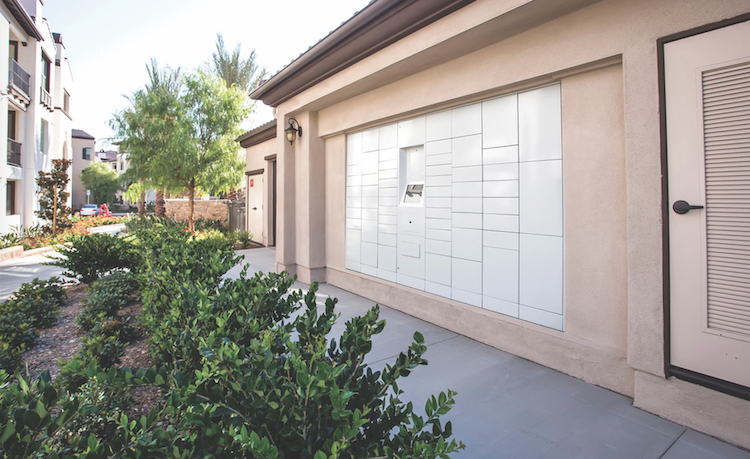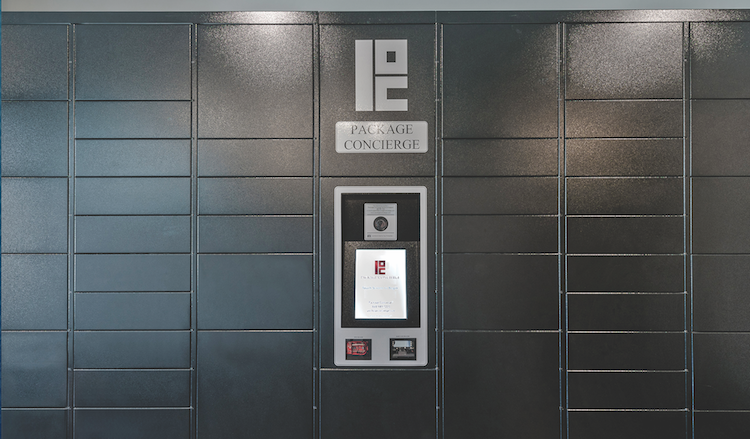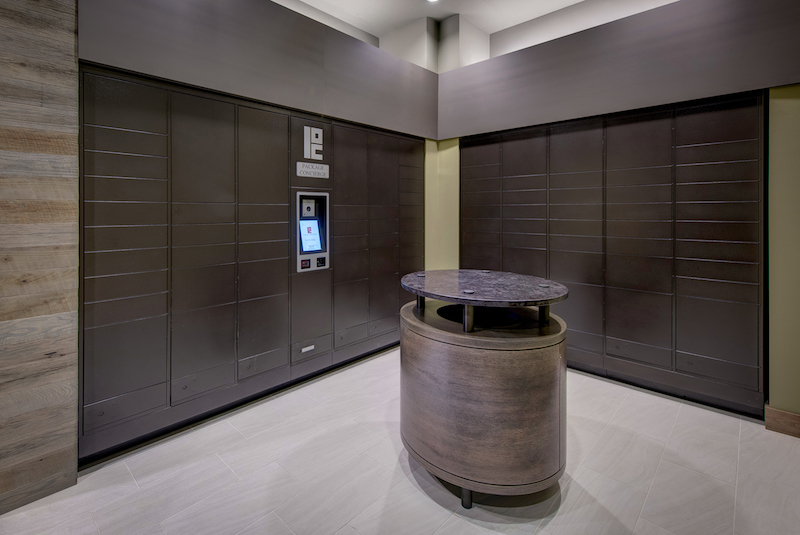Why did you refuse that?” George Costanza asks Jerry in a 1996 episode of “Seinfeld.” “Everybody loves a package.”
That might have been true back then, when Amazon was a mere online bookstore and receiving a package hadn’t become part of the daily routine. Today, anyone managing a decent-sized apartment or condo community may find the onslaught of packages overwhelming. With residents able to get delivery of anything from a pack of gum, to a $600 iPhone, to the refrigerated ingredients for that night’s dinner, multifamily complexes are awash in a swirling tide of cardboard boxes and plastic bags.
“The exponential growth of Amazon and other package delivery services has had a profound impact on the design of today’s multifamily communities,” says Rohit Anand, AIA, NCARB, Principal, KTGY Architecture + Planning. “Everything from groceries, to dry cleaning, to traditional online purchases is being delivered on a daily basis, leaving it up to property managers to determine how best to distribute them to residents.” In some cases, says Anand, residents expect around-the-clock access to their packages due to their busy schedules.
The solution: dedicated package delivery centers. Such facilities have been around for the last decade or so in some multifamily communities, but have grown in number and sophistication as the flood of packages has risen, and as residents’ reliance on them has gone up exponentially. Apartment managers and condominium associations also have to be concerned about legal liabilities associated with lost or damaged packages, and the mounting cost of staff hours devoted to accept and deliver packages.
DEFINING THE PACKAGE CENTER
A package center is a dedicated, secure space for delivered packages to be stored until residents can pick them up (or, in some cases, have them delivered directly to their units). Some centers take the form of a traditional mailroom, staffed with personnel to retrieve and manage packages for residents. But employing enough staff to allow residents 24/7 access to their packages can become difficult and expensive, so package delivery centers are automating.
Automated systems, such as those provided by Package Concierge or Parcel Pending, store packages in secure lockers. When a courier delivers a package, he/she will follow the integrated touchscreen’s prompts to enter the recipient’s name and select an appropriately sized locker. A locker will then open and the package can be placed inside.
Once the locker door is closed, a text message is sent automatically to the recipient alerting the person of the package’s arrival and providing a unique PIN. To get the package, the resident need only enter the PIN and the locker door will automatically open. Residents can access their packages any time, day or night.
 The Palisades at Sierra del Oro, Corona, Calif., developed by MBK Rental Living, uses an automated center to give residents 24/7 access to deliveries. Photo: MBK Rental Living
The Palisades at Sierra del Oro, Corona, Calif., developed by MBK Rental Living, uses an automated center to give residents 24/7 access to deliveries. Photo: MBK Rental Living
Due to the ever-increasing volume of deliveries, package centers are getting bigger and bigger. “Prior to the recession, we would allocate about one square foot of wall area per unit when designing a package room,” says Anand. “We later doubled that number to two square feet, and now are finding that we need to set aside three square feet per unit in some of the newest residential communities.”
Kass Management offers a service called Doorman, where packages are collected at an off-site location until residents can arrange for pickup. “We wanted a solution that addressed the need, yet was still economical,” says Kass’s Mark Durakovic, Principal.
Steven Fifield, President of Fifield Companies, says his company is even coordinating deliveries of “lifestyle-service” providers—Pilates instructors, dog groomers, personal chefs—who perform in-home services for apartment and condo dwellers.
Then there’s the proliferation of food-delivery services like Peapod and Blue Apron. To keep food from spoiling, package centers are starting to incorporate refrigerated rooms or lockers. RMK Management Corp. is retrofitting some properties with coolers and installing refrigeration rooms in new developments. “Refrigeration was virtually nonexistent before the recession,” Anand says. “Today, it is offered in approximately 10% of new residential communities.”
IT’S A COMMUNITY AFFAIR
Many rental and condominium communities integrate package centers into high-traffic areas. Not only does this make it easier for couriers to find the center and deliver packages, it also makes receiving a package a neighborly event.
If planned and designed appropriately, package centers can strengthen community ties among residents. The inclusion of communal tables and recycling bins gives residents the option to open their packages immediately while socializing with their neighbors. “Ultimately, it’s about the resident experience,” says Anand. “As designers, how can we create a community where serendipitous encounters lead to long-lasting relationships among residents?”
What about drone deliveries? Now that Amazon Prime Air and others are toying with the idea, figuring how best to integrate drone deliveries with package centers may prove to be a bit of a head-scratcher for designers. “Drones and packaging centers will need to be compatible,” says Rick Fletcher, Vice President of Sales & Marketing, MBK Homes.
But large-scale package delivery via drones does not appear to be imminent. There are plenty of logistical and regulatory hurdles Amazon and its online siblings will have to overcome before the skies will be filled with the sonorous buzz of package-laden drones.
 With the Package Concierge touchscreen at Village Plaza, Chapel Hill, N.C., designed by KTGY Architecture, the tenant follows the touchscreen prompts, enters a PIN, and the correct locker automatically opens. Photo: courtesy KTGY Architecture
With the Package Concierge touchscreen at Village Plaza, Chapel Hill, N.C., designed by KTGY Architecture, the tenant follows the touchscreen prompts, enters a PIN, and the correct locker automatically opens. Photo: courtesy KTGY Architecture
Related Stories
Codes and Standards | Mar 15, 2024
Technical brief addresses the impact of construction-generated moisture on commercial roofing systems
A new technical brief from SPRI, the trade association representing the manufacturers of single-ply roofing systems and related component materials, addresses construction-generated moisture and its impact on commercial roofing systems.
Sports and Recreational Facilities | Mar 14, 2024
First-of-its-kind sports and rehabilitation clinic combines training gym and healing spa
Parker Performance Institute in Frisco, Texas, is billed as a first-of-its-kind sports and rehabilitation clinic where students, specialized clinicians, and chiropractic professionals apply neuroscience to physical rehabilitation.
Market Data | Mar 14, 2024
Download BD+C's March 2024 Market Intelligence Report
U.S. construction spending on buildings-related work rose 1.4% in January, but project teams continue to face headwinds related to inflation, interest rates, and supply chain issues, according to Building Design+Construction's March 2024 Market Intelligence Report (free PDF download).
Apartments | Mar 13, 2024
A landscaped canyon runs through this luxury apartment development in Denver
Set to open in April, One River North is a 16-story, 187-unit luxury apartment building with private, open-air terraces located in Denver’s RiNo arts district. Biophilic design plays a central role throughout the building, allowing residents to connect with nature and providing a distinctive living experience.
Sustainability | Mar 13, 2024
Trends to watch shaping the future of ESG
Gensler’s Climate Action & Sustainability Services Leaders Anthony Brower, Juliette Morgan, and Kirsten Ritchie discuss trends shaping the future of environmental, social, and governance (ESG).
Affordable Housing | Mar 12, 2024
An all-electric affordable housing project in Southern California offers 48 apartments plus community spaces
In Santa Monica, Calif., Brunson Terrace is an all-electric, 100% affordable housing project that’s over eight times more energy efficient than similar buildings, according to architect Brooks + Scarpa. Located across the street from Santa Monica College, the net zero building has been certified LEED Platinum.
Museums | Mar 11, 2024
Nebraska’s Joslyn Art Museum to reopen this summer with new Snøhetta-designed pavilion
In Omaha, Neb., the Joslyn Art Museum, which displays art from ancient times to the present, has announced it will reopen on September 10, following the completion of its new 42,000-sf Rhonda & Howard Hawks Pavilion. Designed in collaboration with Snøhetta and Alley Poyner Macchietto Architecture, the Hawks Pavilion is part of a museum overhaul that will expand the gallery space by more than 40%.
Affordable Housing | Mar 11, 2024
Los Angeles’s streamlined approval policies leading to boom in affordable housing plans
Since December 2022, Los Angeles’s planning department has received plans for more than 13,770 affordable units. The number of units put in the approval pipeline in roughly one year is just below the total number of affordable units approved in Los Angeles in 2020, 2021, and 2022 combined.
BIM and Information Technology | Mar 11, 2024
BIM at LOD400: Why Level of Development 400 matters for design and virtual construction
As construction projects grow more complex, producing a building information model at Level of Development 400 (LOD400) can accelerate schedules, increase savings, and reduce risk, writes Stephen E. Blumenbaum, PE, SE, Walter P Moore's Director of Construction Engineering.
AEC Tech | Mar 9, 2024
9 steps for implementing digital transformation in your AEC business
Regardless of a businesses size and type, digital solutions like workflow automation software, AI-based analytics, and integrations can significantly enhance efficiency, productivity, and competitiveness.

















